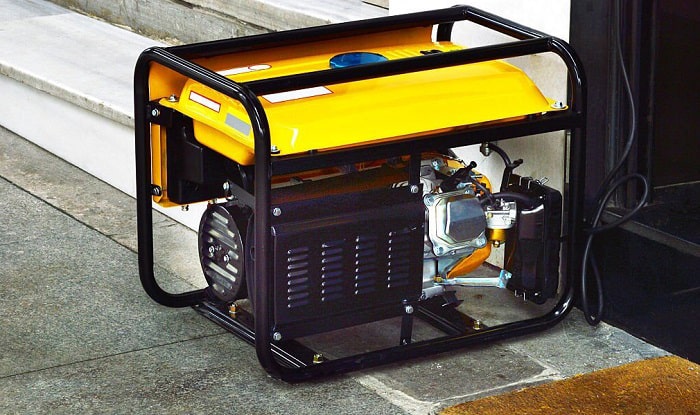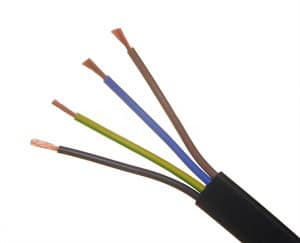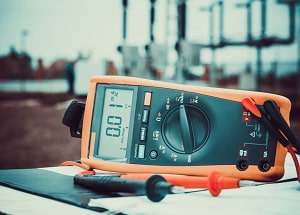Due to limited availability and rising costs, it’s well worth knowing how to make a 50 amp generator cord using your own materials. The keywords here are “safely” and “properly.”
I’m going to make it clear from the start that this guide will not teach you and does not encourage the use of a 50 amp male to male generator cord. It’s not for nothing that electricians call a backfeed generator cord a “suicide cord”.
Rather, I will mostly be explaining how to build a basic and guaranteed safe 50 amp generator cable using a 6-gauge wire attached to male and female plugs.
Table of Contents
- Items to Get Before Starting
- Step-by-Step Guide to Make a 50A Generator Cord
- Step 1. Separate the female plug from its base or cover shell, then slide the 6-gauge cable into its opening.
- Step 2. Remove 1 ½ inch of the cable’s outer insulation at its end.
- Step 3. Cut off the unneeded threads, then refer to the manual to know how much insulation you need to cut off from each wire.
- Step 4. Strip each wire using automatic wire strippers, then put a ferrule on each end.
- Step 5. Slot the wires into the right holes on the plug, then screw them in place.
- Step 6. Follow the same steps above for the male end, then test the cord before using it.
- FAQs
- Conclusion
Items to Get Before Starting
- Female and male twist lock plugs
- 6/4 SOOW 6-gauge cable (with length appropriate for your purposes)
- Screwdriver
- Cable cutter
- Wire strippers with 6 AWG capacity
- Sharpie marker
- Wire ferrules (optional)
- Crimping tool (optional)
- Multimeter
Step-by-Step Guide to Make a 50A Generator Cord
Take note that these steps work for most generator cable types or smaller and larger cords. After all, they’re mostly just concerned with correctly connecting the plugs.
Step 1. Separate the female plug from its base or cover shell, then slide the 6-gauge cable into its opening.
A standard female 50 amp plug for the generator comes connected to a base or black shell cover. You have to unscrew two screws attaching the plug to the cover. Doing so will loosen the cover, so the generator power cable can slide in.
If you’re using a plug with no clamp and just a sleeve that you can pull off, just make sure to buy a cable that will fit the male and female plugs’ respective bases.
Step 2. Remove 1 ½ inch of the cable’s outer insulation at its end.
You have to access the four wires inside, so strip 1 ½ inch of the black insulation. To make sure you don’t end up cutting the precious internal wires, I recommend using a cable cutter.
Measure and mark the spot where you will be making the cut on the cable with a marker. Clamp the cable cutter on the spot, then rotate it a few times until you feel the insulation slowly coming off. Stop once you can pull the cut part of the insulation off.
Step 3. Cut off the unneeded threads, then refer to the manual to know how much insulation you need to cut off from each wire.
Now that the wires are free, you may need to cut off a short section of their coverings.
The general recommendation for wire stripping is 1 inch. However, it’s always best to follow the wire manufacturer’s instructions in this regard. Some may call for only ½ inch to be stripped, after all. This is why I highly suggest you refer to the manual before cutting off the insulation.
Step 4. Strip each wire using automatic wire strippers, then put a ferrule on each end.
Automatic wire strippers will get this done for you in seconds and in a single cutting action, so I recommend you use them for this purpose. Insert the wire using the correct guide for 6-gauge wires.
From here, you can either twist the exposed wires to make them as compact and close-knit as possible or use ferrules to house them. I recommend doing the latter.
Even better if you twist each end nice and tight first, then use the ferrules. Not only will ferrules make it easier for you to screw each wire in place later, but they also help in reducing fraying and minimizing electrocution risk.
You have to use a crimping tool if you decide to go down that route. Please watch this video on how to do it:
Step 5. Slot the wires into the right holes on the plug, then screw them in place.
Now that the wires are ready to be socketed into the plug’s holes, take note of the label and color code on each one. Most portable generator cables and connectors come with plugs containing color codes.
Red (X) and black (Y) wires are your hot wires, while white (W) and green (G) are neutral and ground wires, respectively. You may struggle a bit in inserting them all, but most wires are flexible enough to be manipulated into holes, so keep trying!
Some can vouch for inserting all wires at once, while others prefer to do it one by one. Figure out which method works well for you. Screw each wire in place the moment you know they’re snugly inside each hole.
Slide the base over to the end, then attach it to the plug. You may need to remove the clamps first if your plug has them.
Make sure the cable’s correctly in position, and there are no gaps where dust may enter. Afterward, re-screw the clamps until they’re tight.
If you have sleeves, slide them up while minding the screws that will be needed to keep them in place. Tighten everything down to be sure.
Step 6. Follow the same steps above for the male end, then test the cord before using it.
Once finished with the female plug, you now need to repeat all of the above steps for the male generator cord twist lock plug.
With male ends now ready to be plugged, all you need to do is to test for continuity on all the pins on both plugs. A multimeter with continuity mode should make this a breeze for you. You will have to correct the wire connections if you notice any spots with no continuity.
FAQs
What kind of wire do I need for a 50 amp generator?
Wire size is important in preventing overheating, so be sure you’re using the correct 50 amp generator wire. It should be a 6-gauge copper wire since this type can handle up to 65 amps. That’s more than enough, even with the 80% NEC rule factored in.
Do I need a 50 amp cord for my generator?
The right cord for the generator suits what the generator’s most powerful outlet requires. It’s straightforward, really.
A 30 amp outlet works best with a 30 amp generator cord, so it’s logical that if you have a 50 amp outlet as the maximum, you need a 50 amp cord.
How long can a 50 amp cord be?
A lot of people also ask me, “How long can a 50 amp generator cord be?” Generator cords span 100 feet at most.
Be careful about longer lengths, though, as most cords that exceed 85 to 100 ft may already have a significant voltage drop (around 3% or more), which lowers the amount of electricity they send to devices.
Related posts you may also like:
- 5 Steps to Connect Generator to House without Transfer Switch
- The Most Effective Way to Reset Generator Circuit Breaker
Conclusion
Now, you know how to make a 50 amp generator cord following the simple steps mentioned above. It’s important from the preparation process, as you need to use a 6-gauge cable and buy female and male twist plugs. Make sure to do the steps fỏ both female and male plugs, then test every pin for continuity.

I am Edwin Jones, in charge of designing content for Galvinpower. I aspire to use my experiences in marketing to create reliable and necessary information to help our readers. It has been fun to work with Andrew and apply his incredible knowledge to our content.



